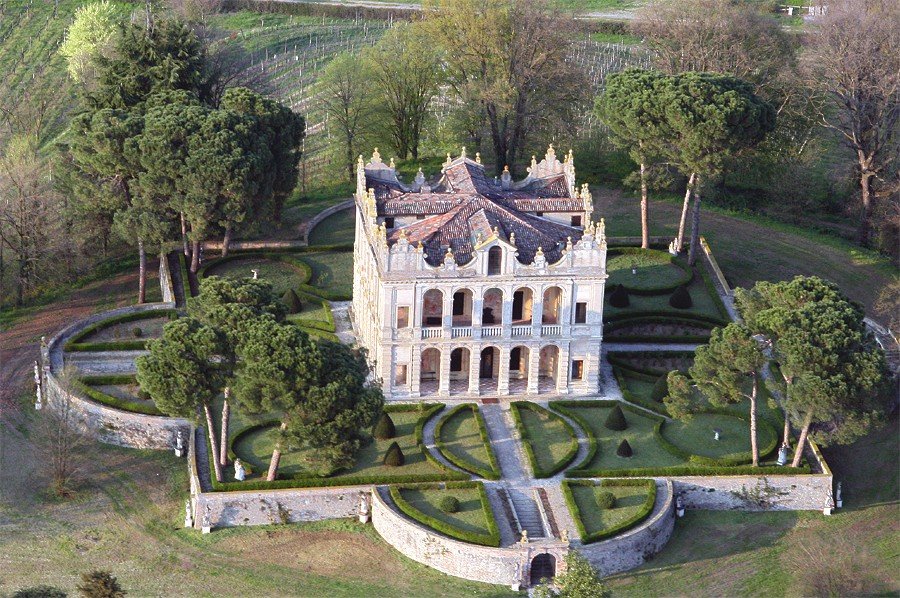
Villas of the Veneto – Lower Padua and the Colli Euganei
Villa Roberti Bozzolato called ‘the Palace’in Brugine
The building has got a lenghtened rectangular plan with an entrance loggia enclosed in one of the short sides. In the centre there is a narrow and long hall dividing the villa into two sectors.
Villa Garzoni Carraretto in Pontecasale
It was built by Jacopo Sansovino. The villa is reminiscent of the Venetian works by Sansovino. It is a construction arranged in ‘U’ shape containing an original hanging courtyard which is delimited at its ends by a colonnade supporting some statues. You can enter from the lawn through a slight flight of steps to reach the front façade.
(It can be visited by appointment)
Villa Widmann Borlettiin Bagnoli di Sopra
The long edifice was a monastery which in 1600s was transformed into the country residence following the project of Baldassarre Longhena. (Only the gardens can be visited)
 Villa Contarini Maldura Emoin Monselice
It is a small but refined construction of palladian inspiration dating back to 1588. The villa rises on a nearly perfectly cubic block and has got a four slopes roof and plain rectangular windows. On the façade there is a tetrastyle pronao supporting a massive tympanum.
(It can be visited by request).
Villa Selvatico Emo Capodilistain Battaglia Terme
Due to its extravagant shape it has become the symbol of the Baroque age as far as villas are concerned. The effect deriving from that is the idea that it is a villa enclosed in a castle owing to the fact that it has got four embattled towers at the corners of the construction. (It can be visited only on reservation)
The Catajo in Battaglia Terme
An impressive and austere mass adorned with battlements, it was built towards 1570 for the family Obizzi. (It can be visited on Sundays)
Villa Contarini Maldura Emoin Monselice
It is a small but refined construction of palladian inspiration dating back to 1588. The villa rises on a nearly perfectly cubic block and has got a four slopes roof and plain rectangular windows. On the façade there is a tetrastyle pronao supporting a massive tympanum.
(It can be visited by request).
Villa Selvatico Emo Capodilistain Battaglia Terme
Due to its extravagant shape it has become the symbol of the Baroque age as far as villas are concerned. The effect deriving from that is the idea that it is a villa enclosed in a castle owing to the fact that it has got four embattled towers at the corners of the construction. (It can be visited only on reservation)
The Catajo in Battaglia Terme
An impressive and austere mass adorned with battlements, it was built towards 1570 for the family Obizzi. (It can be visited on Sundays)
 Villa dei Vescovi now Olcesein Torreglia, Luvigliano
This villa for the bishops of Padua was begun in 1474 and ordered by Bartolomeo Bon. It is a stately construction erected on an artificial embankment which allows people to dominate the surrounding area. (It can be visited).
Villa Emo Capodilista in Selvazzano
It was built in late 1500s by Dario Varotari for the family Emo: its significant elements are the sixteenth century frescoes and the architectural pieces dating back to 1700s.
Villa dei Vescovi now Olcesein Torreglia, Luvigliano
This villa for the bishops of Padua was begun in 1474 and ordered by Bartolomeo Bon. It is a stately construction erected on an artificial embankment which allows people to dominate the surrounding area. (It can be visited).
Villa Emo Capodilista in Selvazzano
It was built in late 1500s by Dario Varotari for the family Emo: its significant elements are the sixteenth century frescoes and the architectural pieces dating back to 1700s.